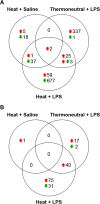Immunomodulatory effects of heat stress and lipopolysaccharide on the bursal transcriptome in two distinct chicken lines
- PMID: 30165812
- PMCID: PMC6117931
- DOI: 10.1186/s12864-018-5033-y
Immunomodulatory effects of heat stress and lipopolysaccharide on the bursal transcriptome in two distinct chicken lines
Abstract
Background: Exposure to heat stress suppresses poultry immune responses, which can increase susceptibility to infectious diseases and, thereby, intensify the negative effects of heat on poultry welfare and performance. Identifying genes and pathways that are affected by high temperatures, especially heat-induced changes in immune responses, could provide targets to improve disease resistance in chickens. This study utilized RNA-sequencing (RNA-seq) to investigate transcriptome responses in the bursa of Fabricius, a primary immune tissue, after exposure to acute heat stress and/or subcutaneous immune stimulation with lipopolysaccharide (LPS) in a 2 × 2 factorial design: Thermoneutral + Saline, Heat + Saline, Thermoneutral + LPS and Heat + LPS. All treatments were investigated in two chicken lines: a relatively heat- and disease-resistant Fayoumi line and a more susceptible broiler line.
Results: Differential expression analysis determined that Heat + Saline had limited impact on gene expression (N = 1 or 63 genes) in broiler or Fayoumi bursa. However, Thermoneutral + LPS and Heat + LPS generated many expression changes in Fayoumi bursa (N = 368 and 804 genes). Thermoneutral + LPS was predicted to increase immune-related cell signaling and cell migration, while Heat + LPS would activate mortality-related functions and decrease expression in WNT signaling pathways. Further inter-treatment comparisons in the Fayoumi line revealed that heat stress prevented many of the expression changes caused by LPS. Although fewer significant expression changes were observed in the broiler bursa after exposure to Thermoneutral + LPS (N = 59 genes) or to Heat + LPS (N = 146 genes), both treatments were predicted to increase cell migration. Direct comparison between lines (broiler to Fayoumi) confirmed that each line had distinct responses to treatment.
Conclusions: Transcriptome analysis identified genes and pathways involved in bursal responses to heat stress and LPS and elucidated that these effects were greatest in the combined treatment. The interaction between heat and LPS was line dependent, with suppressive expression changes primarily in the Fayoumi line. Potential target genes, especially those involved in cell migration and immune signaling, can inform future research on heat stress in poultry and could prove useful for improving disease resistance.
Keywords: Bursa; Chicken; Heat stress; Lipopolysaccharide; RNA-seq; Transcriptome.
Conflict of interest statement
Ethics approval
All experiments involving animals were approved by the Institutional Animal Care and Use Committee at Iowa State University (ISU) (protocol # 4-11-7128-G).
Consent for publication
Not applicable.
Competing interests
The authors declare that they have no competing interests.
Publisher’s Note
Springer Nature remains neutral with regard to jurisdictional claims in published maps and institutional affiliations.
Figures





Similar articles
-
Genetic lines respond uniquely within the chicken thymic transcriptome to acute heat stress and low dose lipopolysaccharide.Sci Rep. 2019 Sep 20;9(1):13649. doi: 10.1038/s41598-019-50051-0. Sci Rep. 2019. PMID: 31541148 Free PMC article.
-
Bursal transcriptome profiling of different inbred chicken lines reveals key differentially expressed genes at 3 days post-infection with very virulent infectious bursal disease virus.J Gen Virol. 2018 Jan;99(1):21-35. doi: 10.1099/jgv.0.000956. Epub 2017 Oct 23. J Gen Virol. 2018. PMID: 29058656
-
Unique genetic responses revealed in RNA-seq of the spleen of chickens stimulated with lipopolysaccharide and short-term heat.PLoS One. 2017 Feb 6;12(2):e0171414. doi: 10.1371/journal.pone.0171414. eCollection 2017. PLoS One. 2017. PMID: 28166270 Free PMC article.
-
Infectious Bursal Disease: a complex host-pathogen interaction.Dev Comp Immunol. 2013 Nov;41(3):429-38. doi: 10.1016/j.dci.2013.03.017. Epub 2013 Apr 6. Dev Comp Immunol. 2013. PMID: 23567344 Review.
-
Deciphering desirable immune responses from disease models with resistant and susceptible chickens.Poult Sci. 2019 Apr 1;98(4):1634-1642. doi: 10.3382/ps/pey535. Poult Sci. 2019. PMID: 30534980 Free PMC article. Review.
Cited by
-
Immunogenicity of Type IV Pilin Proteins from Clostridium perfringens in Chickens.Microorganisms. 2025 Jan 9;13(1):120. doi: 10.3390/microorganisms13010120. Microorganisms. 2025. PMID: 39858888 Free PMC article.
-
Effects of Spirulina platensis and/or Allium sativum on Antioxidant Status, Immune Response, Gut Morphology, and Intestinal Lactobacilli and Coliforms of Heat-Stressed Broiler Chicken.Vet Sci. 2023 Nov 27;10(12):678. doi: 10.3390/vetsci10120678. Vet Sci. 2023. PMID: 38133229 Free PMC article.
-
Induction of Chicken Host Defense Peptides within Disease-Resistant and -Susceptible Lines.Genes (Basel). 2020 Oct 14;11(10):1195. doi: 10.3390/genes11101195. Genes (Basel). 2020. PMID: 33066561 Free PMC article.
-
Genetic lines respond uniquely within the chicken thymic transcriptome to acute heat stress and low dose lipopolysaccharide.Sci Rep. 2019 Sep 20;9(1):13649. doi: 10.1038/s41598-019-50051-0. Sci Rep. 2019. PMID: 31541148 Free PMC article.
-
Molecular mechanisms of growth depression in broiler chickens (Gallus Gallus domesticus) mediated by immune stress: a hepatic proteome study.J Anim Sci Biotechnol. 2021 Jul 13;12(1):90. doi: 10.1186/s40104-021-00591-1. J Anim Sci Biotechnol. 2021. PMID: 34253261 Free PMC article.
References
-
- IPCC. Climate Change 2013: The physical science basis . Contribution of Working Group I to the fifth assessment report of the Intergovernmental Panel on Climate Change. New York: Cambridge University Press; 2013.
MeSH terms
Substances
Grants and funding
LinkOut - more resources
Full Text Sources
Other Literature Sources

